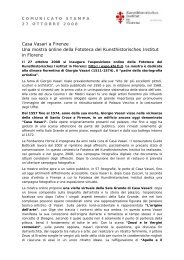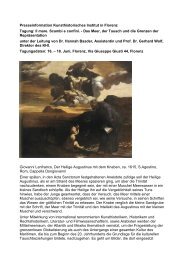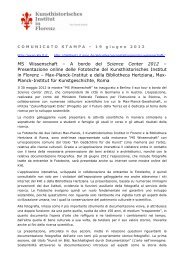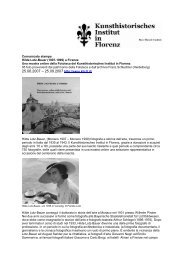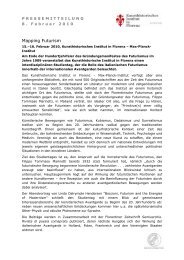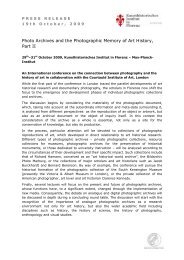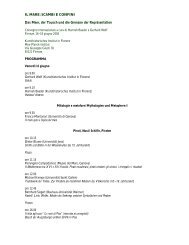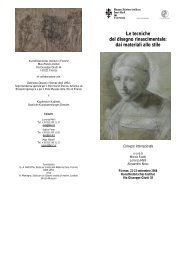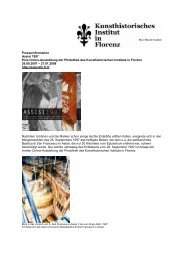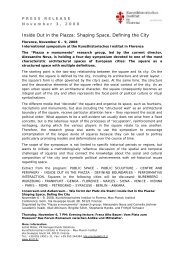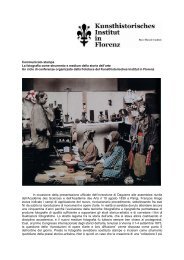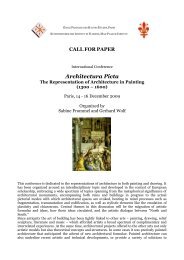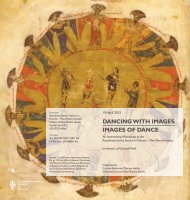forschungsbericht november 2008 – juli 2012 - Kunsthistorisches ...
forschungsbericht november 2008 – juli 2012 - Kunsthistorisches ...
forschungsbericht november 2008 – juli 2012 - Kunsthistorisches ...
Erfolgreiche ePaper selbst erstellen
Machen Sie aus Ihren PDF Publikationen ein blätterbares Flipbook mit unserer einzigartigen Google optimierten e-Paper Software.
PROMOVIERENDE | 77<br />
The Transformation of Neighboring Artistic Languages in the Miniature of the<br />
Armenian Kingdom of Cilicia during the Last Decades of the 13 th Century<br />
Satenik Chookaszian | Art, Space and Mobility<br />
Second Canon table of Cilician Gospel,<br />
13 th century, Yerevan (Armenia),<br />
Matenadaran N. 9422<br />
The richly illustrated Gospel No. 9422 of Matenadaran has<br />
long been considered one of the best examples of royal<br />
Cilician Armenian patronage of the late thirteenth century.<br />
The project examines encounters between Eastern and<br />
Western art in the analysis of the miniatures of the manuscript.<br />
In particular, it focuses on the opening series of images<br />
which accompany the Canon tables and gather a great<br />
variety of imported motifs. The successful synthesis of extraneous<br />
elements resulted in a unique graphic idiom. By<br />
investigating the connections between Byzantine and Italian<br />
painting in the Canon tables as well as considering parallel<br />
developments in related Byzanto-Italian productions, for example in icons preserved<br />
in the Monastery of St. Catherine at Mount Sinai, this study aims to highlight the network<br />
of cross-cultural relations in which Armenian art participated.<br />
Corpus of Images of the Prophet Muhammad in Manuscripts and Frescos,<br />
c. 1100<strong>–</strong>1500<br />
Heather Coffey | Crossing Boundaries, Creating Images: In Search of the Prophet Muhammad in<br />
Literary and Visual Traditions<br />
Master Vitae Imperatorum, Inferno<br />
XVIII of the Divina Commedia, Lombard,<br />
ca. 1440, Paris, B.N. it. 2017,<br />
366r<br />
After continuous scholarly neglect, newly-found representations<br />
of the Prophet Muhammad continue to surface in public<br />
archives, museums, and private collections, ensuring that the<br />
known corpus of images of the Prophet is steadily expanding.<br />
Over seventy surviving images of the Prophet in manuscripts<br />
made in European scriptoria have been identified. These images<br />
are interpolated into a range of texts, including biblical exegeses,<br />
apocalyptic commentaries, universal chronicles, and polemical<br />
biographies. Select pictorial examples also appear in stained<br />
glass and large-scale fresco paintings. Research completed at the<br />
<strong>Kunsthistorisches</strong> Institut between 2009 and 2011 facilitated the<br />
authorship of a database of images of the Prophet produced in<br />
Christian Europe, in conjunction with my doctoral dissertation (submitted to the School<br />
of Graduate Studies at Indiana University in <strong>2012</strong>). My dissertation, entitled Images of the<br />
Prophet Muhammad in the Late Medieval West: From Joachim of Fiore to Dante Alighieri, examines<br />
a pejorative rendering of the Prophet Muhammad, and of Islam, in a collection of painted<br />
picto-diagrams produced in a monastic context in Calabria, Italy, c. 1220.<br />
Alessandro Turchi 1578<strong>–</strong>1649<br />
Davide Dossi | MaxNetAging<br />
Im Zentrum des Dissertationsprojektes steht der aus Verona stammende Maler Alessandro<br />
Turchi (Verona, 1578 <strong>–</strong> Rom, 1649). Zu seinem Werk, das erst seit kürzerer Zeit kunsthistorische<br />
Beachtung findet, möchte es auf mehrfache Weise einen Forschungsbeitrag<br />
leisten: zum einen hinsichtlich einer Rekonstruktion der italienischen Marktbedingungen<br />
der damaligen Zeit sowie Turchis Beitrag zur Ästhetik der Barockmalerei, und zum anderen<br />
zur Frage der Technik und der Materialien Turchis im Verhältnis zu seinem Alter<br />
und den Städten, in denen er tätig war. Dementsprechend ist die Dissertation in drei Teile<br />
gegliedert, wobei sich der erste dem Netz von Auftraggebern und Förderern von Turchi<br />
widmet. Hierfür wurden zahlreiche Dokumente analysiert, anhand derer gezeigt werden



